Dynamic Tree Bracing: The Modern Approach to Flexible Tree Support Systems
Understanding Flexible Support Solutions for Tree Health and Stability
In today’s urban and suburban landscapes, trees face increasing challenges from extreme weather events, confined growing spaces, and structural defects. When valuable trees show signs of weakness or potential failure, property owners often seek solutions that preserve these assets while ensuring safety. Dynamic tree bracing represents the cutting-edge approach to tree support, offering flexible systems that work with—rather than against—a tree’s natural biology.
Unlike traditional rigid bracing that restricts movement, dynamic systems allow controlled sway while providing crucial support during critical stress periods. This innovative arboricultural technique helps preserve tree health, extend lifespans, and maintain the aesthetic and environmental benefits that mature trees provide to your landscape.
The Evolution of Tree Support Systems
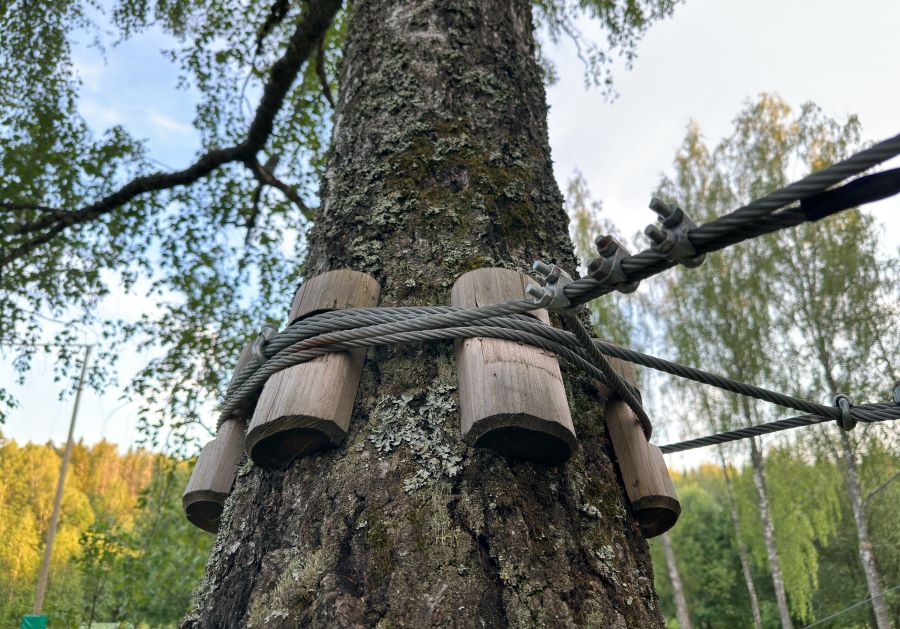
Tree support technology has evolved significantly over the past few decades. Early methods often involved rigid metal rods and inflexible cables that prevented natural movement—unknowingly creating other problems while solving immediate concerns. Modern arboriculture now recognizes that trees require controlled movement to develop proper trunk taper, strong reaction wood, and healthy root systems.
Dynamic bracing represents the culmination of this scientific understanding, combining engineering principles with biological knowledge to create support systems that respect tree physiology while providing necessary reinforcement.
What Is Dynamic Tree Bracing?
The Science Behind Flexible Tree Support
Dynamic tree bracing is a specialized arboricultural technique that uses flexible materials and components designed to allow natural tree movement while providing critical support during extreme loading events. Unlike static systems that fix trees rigidly in place, dynamic bracing incorporates materials that stretch, absorb shock, and permit the controlled swaying motion trees need for proper development.
These systems typically include:
- High-strength synthetic ropes or cables with elastic properties
- Specialized shock-absorbing components
- Connections that adjust to changing tree architecture
- Materials designed to prevent damage to growing tissues
Key Differences Between Dynamic and Static Bracing
The fundamental difference between dynamic and static bracing lies in how each system responds to forces acting on the tree:
Dynamic Bracing:
- Allows controlled movement in normal conditions
- Engages progressively as forces increase
- Permits the tree to build natural strength through controlled stress
- Accommodates growth without adjustment in many cases
- Minimizes damage to living tissues
Static Bracing:
- Restricts natural movement at all times
- Creates constant tension or compression
- May prevent development of reaction wood and natural strength
- Requires frequent adjustment as trees grow
- Can damage living tissues over time
The Biological Importance of Tree Movement
Trees have evolved to respond to movement in specific ways that strengthen their structure. This process, known as thigmomorphogenesis, is crucial for healthy development:
- Trunk taper development – Trees develop thicker, stronger lower trunks when allowed to sway naturally.
- Reaction wood formation – Movement stimulates specialized wood production that reinforces weak areas.
- Root system strengthening – Controlled movement encourages expansive, anchoring root growth.
- Vascular tissue development – Natural flexing promotes optimal vascular tissue patterns.
Dynamic bracing works with these biological processes rather than preventing them, allowing trees to develop their own natural strength while providing backup support when needed.
Benefits of Dynamic Tree Bracing Systems
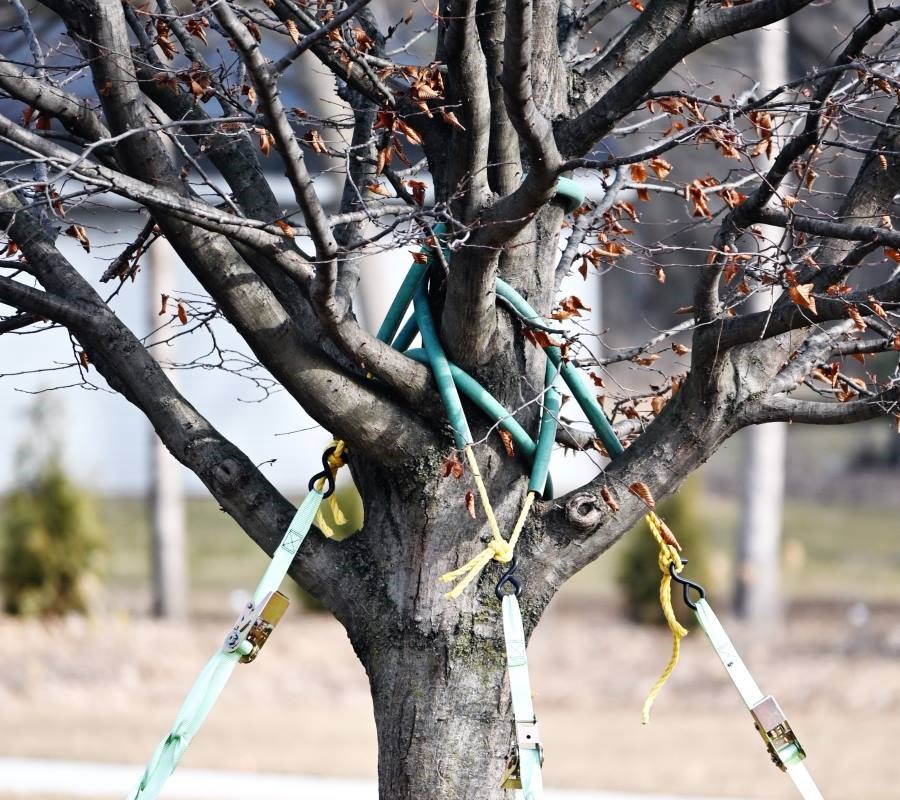
Enhanced Structural Stability While Preserving Natural Growth
Dynamic bracing provides crucial support to structurally compromised trees without the drawbacks of rigid systems:
- Targeted support where needed – Systems can be designed to address specific weak points while leaving healthy sections unrestricted.
- Adaptability to growth – Flexible components adjust as the tree adds diameter and height.
- Reduced impact on cambium and vascular tissues – Specialized attachment methods minimize damage to living tissues.
- Prevention of included bark expansion – Dynamic systems can limit the opening of weak unions without preventing all movement.
Stress Reduction During Extreme Weather Events
Perhaps the most significant benefit of dynamic bracing is its ability to modulate forces during storms, high winds, and snow/ice loading:
- Progressive engagement – Systems activate only when needed, engaging more fully as forces increase.
- Energy absorption – Shock-absorbing components dissipate kinetic energy that would otherwise stress weak points.
- Load distribution – Forces are spread across stronger sections of the tree rather than concentrating at vulnerable areas.
- Failure prevention – By allowing some movement while preventing extreme displacement, these systems reduce catastrophic failures.
Long-Term Health Advantages for Supported Trees
Trees with dynamic bracing typically show better long-term outcomes than those with rigid supports:
- Improved cellular development – Natural movement stimulates healthier cellular structures.
- Better wound response – Trees maintain normal defensive capabilities when not restricted.
- Reduced compensatory growth – Trees don’t develop abnormal growth patterns trying to overcome restrictions.
- Extended lifespan – Many trees with dynamic support systems can safely remain in landscapes for decades longer than would otherwise be possible.
Aesthetic Benefits Compared to Traditional Methods
Beyond the biological advantages, dynamic systems offer aesthetic improvements:
- Less visually intrusive – Modern synthetic materials blend better with tree canopies.
- No hardware damage to bark – Specialized attachment methods prevent the unsightly damage often seen with traditional hardware.
- Preservation of natural appearance – Trees maintain their natural form and movement patterns.
- Fewer pruning artifacts – Less compensatory growth means more natural branch architecture.
When to Consider Dynamic Tree Bracing
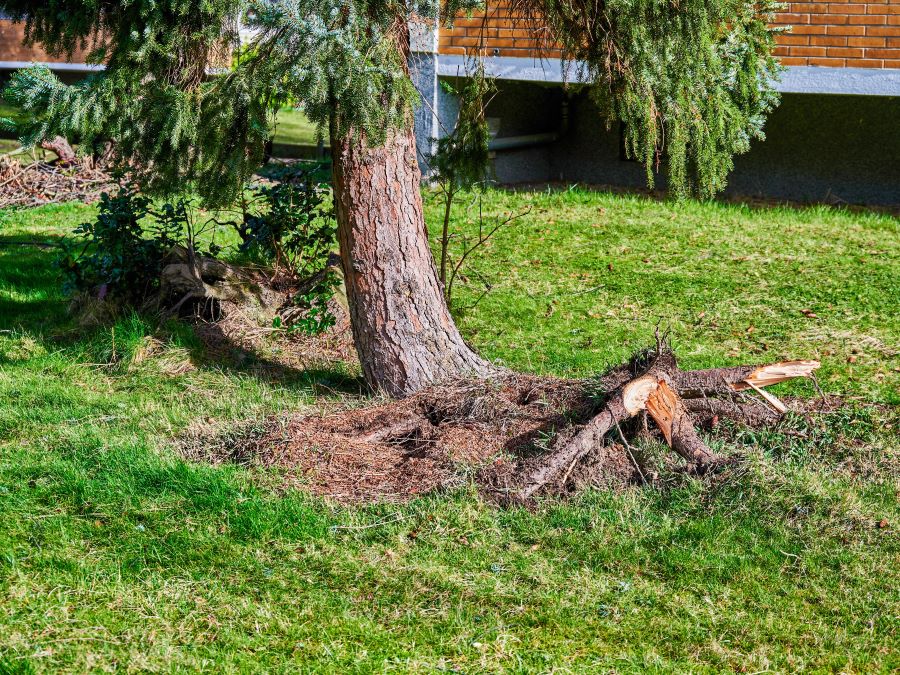
Identifying Trees That Need Support
Several indicators suggest a tree might benefit from dynamic bracing:
- Visible cracks in major unions – Especially those that extend into the trunk
- Included bark in critical junctions – V-shaped unions with bark trapped between stems
- Leaning trunks with recent movement – Particularly those showing soil heaving or root plate lifting
- Split or partially failed branches – When the branch is too valuable to remove
- Historical limb or leader failures – Species with known structural weaknesses
- Multiple stems with weak attachments – Especially in mature specimens
- Heritage or significant specimen trees – When preservation is a priority despite structural issues
Ideal Candidates for Dynamic Support Systems
While many trees can benefit from dynamic bracing, certain situations show the best outcomes:
- Young to middle-aged trees with correctable defects
- Trees with high landscape value that justify the investment
- Species known to develop structural issues (Bradford pears, silver maples, etc.)
- Trees with adequate healthy tissue to support ongoing growth
- Specimens with specific weak points rather than overall decline
- Trees in wind-prone or exposed locations
- Multi-stemmed specimens in otherwise good health
Professional Risk Assessment Process
Properly evaluating candidates for dynamic bracing requires expert assessment:
- Tree Risk Assessment Qualification (TRAQ) evaluation – Systematic analysis of likelihood and consequences of failure
- Identification of specific failure points – Pinpointing exactly where support is needed
- Evaluation of overall tree health – Ensuring the tree can respond positively to the intervention
- Site analysis – Understanding environmental factors that influence risk
- Target assessment – Evaluating what might be damaged if failure occurs
- Cost-benefit analysis – Determining if the investment in bracing is justified
How Dynamic Tree Bracing Systems Work
Advanced Materials in Modern Support Systems
Today’s dynamic bracing systems utilize specialized materials designed specifically for arboricultural applications:
- High-tensile synthetic ropes – Including Cobra® systems, TreeSave®, and similar products
- Elastomeric components – Materials that provide controlled stretch under load
- UV-resistant coatings – Protecting systems from solar degradation
- Abrasion-resistant sleeves – Preventing damage where materials contact bark
- Specialized attachment hardware – Designed to minimize tree injury while maintaining strength
Professional Installation Process
Proper installation is crucial for system effectiveness and tree health:
- Structural analysis – Determining optimal placement and configuration
- Height determination – Typically installed at 2/3 the distance between the defect and the crown
- Proper tensioning – Setting initial tension to allow movement while providing support
- Noninvasive attachment – Using methods that don’t require drilling or significant wounding
- System testing – Ensuring all components function as designed
- Documentation – Recording installation specifications for future reference
Ongoing Monitoring and Maintenance Requirements
Dynamic systems require professional oversight to ensure continued effectiveness:
- Annual inspections – Professional evaluation of system integrity and function
- Tension adjustments – Modifications as the tree grows or the system settles
- Component replacement – Updating parts showing wear or UV degradation
- Expansion as needed – Adding support as tree architecture changes
- Documentation updates – Maintaining records of all inspections and modifications
Dynamic vs. Static Tree Bracing: A Comprehensive Comparison
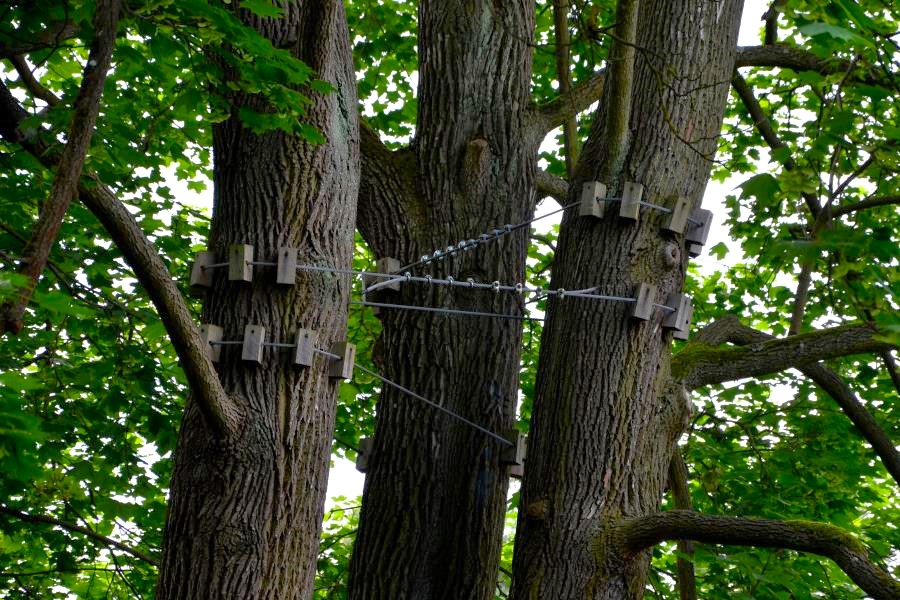
Functional Differences Between Support Philosophies
Understanding the fundamental differences helps inform appropriate system selection:
Dynamic Systems: Working With Natural Movement
- Function as “seat belts” that engage only when needed
- Allow developmental movement while preventing catastrophic failure
- Distribute loads across stronger tree parts
- Permit thigmomorphogenesis (strengthening response to movement)
- Typically install without drilling or significant wounding
Static Systems: Providing Rigid Reinforcement
- Function as constant restraints
- Prevent movement at all times, regardless of force levels
- Concentrate stress at attachment points
- May inhibit natural strengthening responses
- Often require drilling or invasive attachment methods
Selecting the Appropriate System for Your Trees
Several factors influence which system type would best serve a particular tree:
- Defect type and severity – Some critical failures require rigid support
- Tree species characteristics – Growth rate, wood properties, and typical failure patterns
- Loading environment – Wind exposure, snow/ice potential, and site conditions
- Tree age and growth potential – Younger trees benefit more from dynamic systems
- Preservation objectives – Length of time the tree needs to be retained
- Budget considerations – Initial installation and ongoing maintenance costs
Investment Considerations: Costs and Longevity
Typical Investment Range for Professional Installation
Dynamic bracing represents a significant but worthwhile investment for valuable trees:
- Single-stem unions – Typically $300-600 per installation point
- Multiple stem systems – Usually $750-2,000 depending on complexity
- Complex canopy systems – Can range from $1,500-5,000+ for specimen trees
- Factors affecting cost – Tree size, access difficulties, system complexity, and regional labor rates
Expected Service Life of Modern Dynamic Systems
Quality dynamic bracing systems offer excellent longevity:
- Synthetic rope components – 8-12 years before replacement
- Shock absorbers and specialized hardware – 5-8 years depending on exposure
- Protective sleeves and covers – 3-5 years in most environments
- Overall system lifespan – Most require partial replacement/upgrading every 7-10 years
Factors Affecting System Durability
Several variables influence how long a system will function effectively:
- Sun exposure – UV degradation accelerates in high-sun environments
- Precipitation patterns – Frequently wet conditions may accelerate certain types of wear
- Temperature extremes – Affect elastomeric components and synthetic materials
- Tree growth rate – Faster-growing species require more frequent adjustment
- Wind and movement patterns – High-stress environments accelerate component wear
- Installation quality – Proper initial installation significantly extends service life
- Maintenance frequency – Regular professional inspections catch issues before failure
When to Consult a Professional Arborist
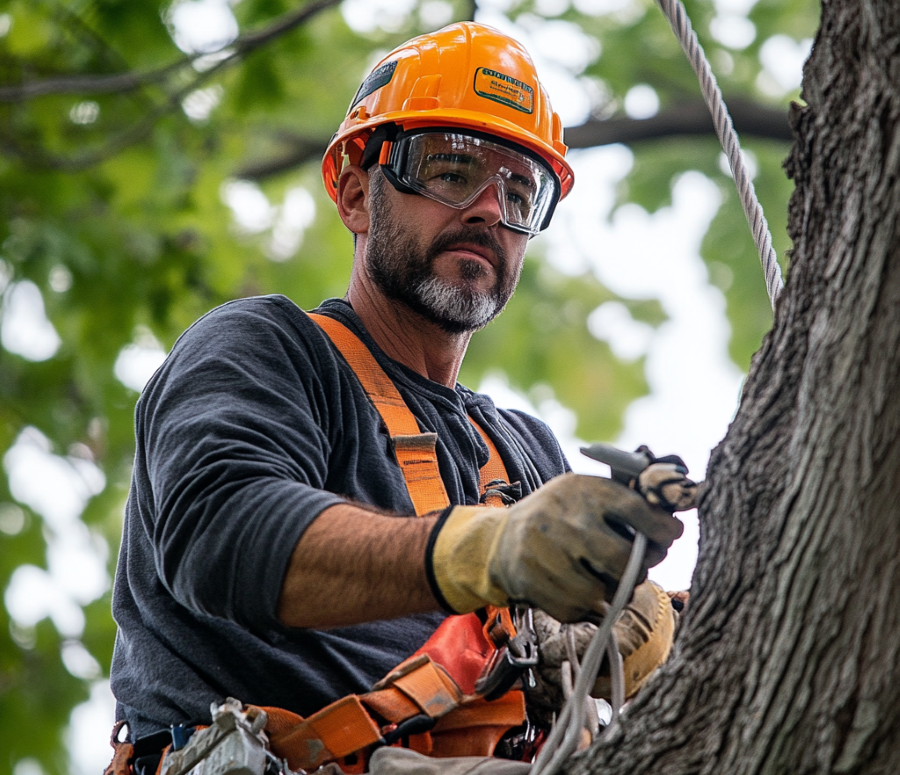
Signs Your Trees Need Expert Evaluation
Consider professional assessment when you observe:
- Visible cracks in major branch unions
- Leaning trunks, especially with recent movement
- Multiple stems growing from the same point
- Previous branch failures on the tree
- Split branches that haven’t completely failed
- Trees with historical or significant landscape value showing structural weakness
Choosing a Qualified Arboricultural Specialist
Look for these qualifications when selecting a professional for dynamic bracing:
- ISA Certification (International Society of Arboriculture)
- TRAQ Qualification (Tree Risk Assessment Qualification)
- Specific training in dynamic support systems
- Experience with similar trees and situations
- References from previous bracing installations
- Proper insurance coverage for technical tree work
- Written specifications detailing the proposed system
Conclusion: Preserving Tree Health Through Advanced Support Technologies
Dynamic tree bracing represents the intersection of modern engineering and biological understanding. By working with a tree’s natural movement patterns while providing crucial support during extreme events, these systems help preserve valuable trees that might otherwise be lost to structural failure.
The investment in professional dynamic bracing pays dividends in extended tree lifespan, reduced risk, preserved property values, and continued environmental benefits from mature trees. When properly installed and maintained by qualified arborists, these systems provide the balance of support and freedom that trees need to thrive in challenging environments.


